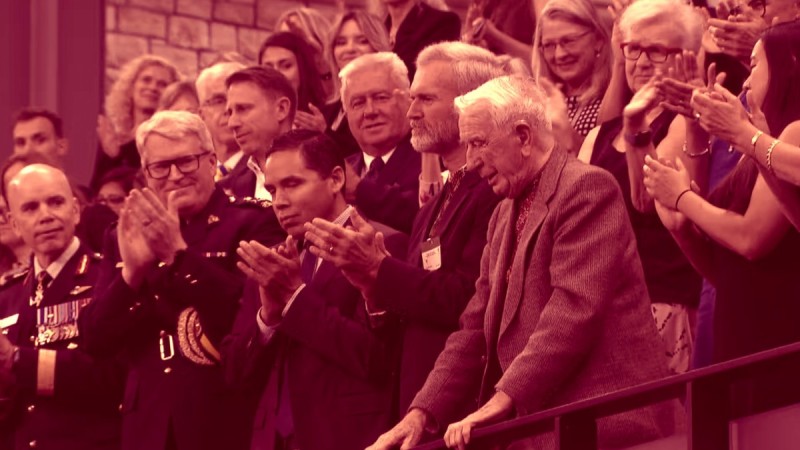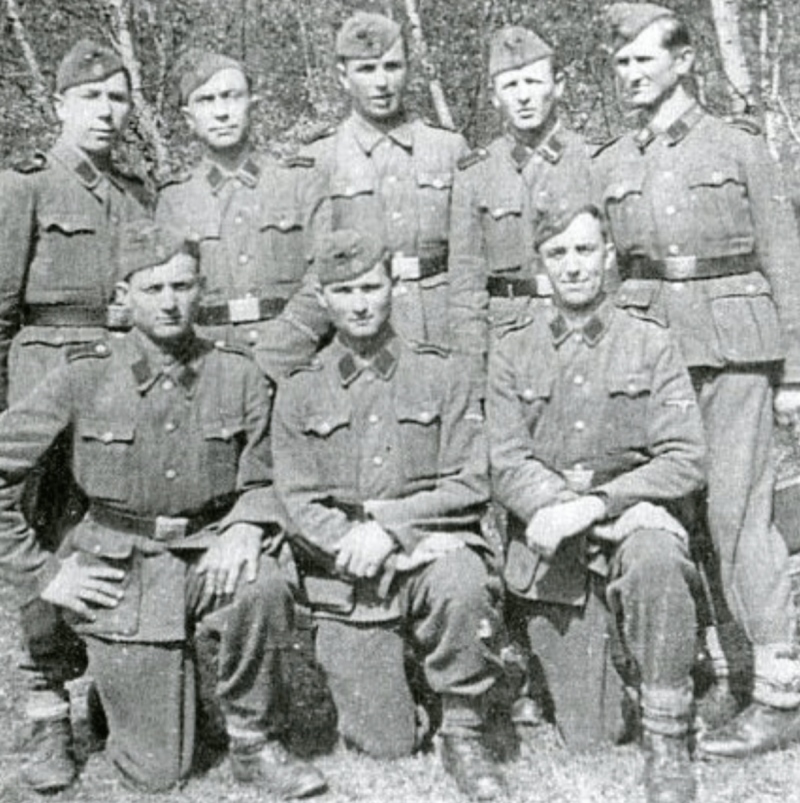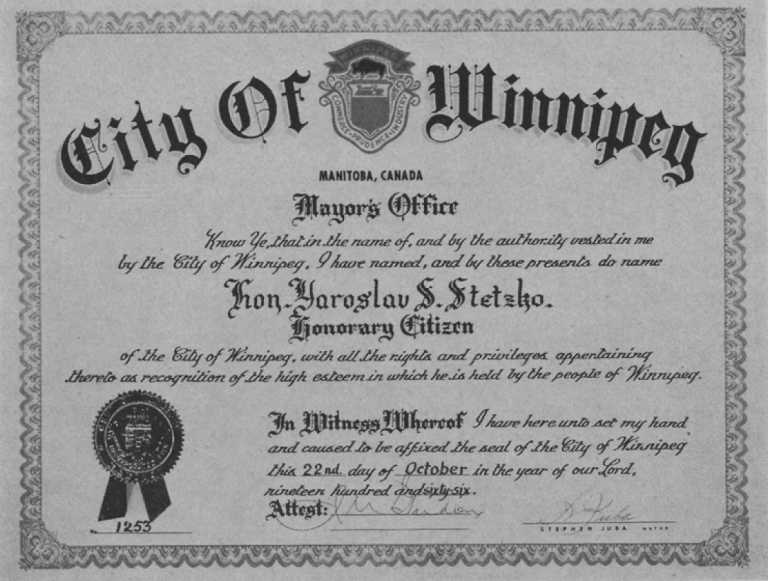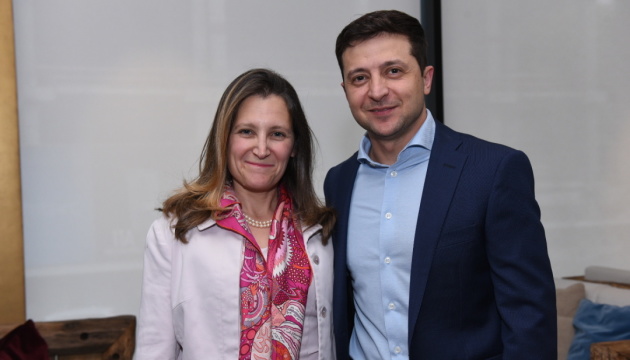Owen Schalk
 Parliamentarians gave a standing ovation to Yaroslav Hunka, a former member of the 14th Waffen Grenadier Division of the SS, the military wing of the Nazi Party, during Ukrainian President Volodymyr Zelensky’s visit to Ottawa. Photo courtesy CBC News.
Parliamentarians gave a standing ovation to Yaroslav Hunka, a former member of the 14th Waffen Grenadier Division of the SS, the military wing of the Nazi Party, during Ukrainian President Volodymyr Zelensky’s visit to Ottawa. Photo courtesy CBC News.
World War II revisionism in Canada is leading to some shocking, dangerous new places.
On September 22, Prime Minister Justin Trudeau welcomed Ukrainian President Volodymyr Zelensky, who is continuing his campaign to shore up Western support amidst his military’s flagging counteroffensive, to address the Canadian parliament.
In attendance and seated in the House of Commons visitors’ gallery was a 98-year old Nazi war veteran named Yaroslav Hunka.
Parliamentarians across party lines, including Trudeau, treated Hunka as a guest of honour. House Speaker Anthony Rota introduced Hunka as a “hero” and a “veteran from the Second World War” who had “fought… against the Russians.” Rota then said that the House of Commons “thank[s] him for all his service” in the fight against Russians during the Second World War. Neither Rota nor anybody present thought to mention the obvious: that those fighting Russia during the war were almost exclusively Nazis.
Not only did nobody seem to notice this shocking omission, the entire House of Commons and President Zelensky rose to applaud Hunka, who served in the 14th SS Division Galicia. Shortly before the end of the war, the unit was renamed the “First Ukrainian Division” in order to remove its association with the Waffen-SS, the military wing of the Nazi Party. In fact, the SS Galicia “subscribed to and served the ideology of Adolf Hitler and SS leader Heinrich Himmler.”
I still can’t believe the entire Canadian parliament gave a standing ovation to a literal Nazi SS officer who fought against the army that liberated Auschwitz, and Canada itself. But it’s true. They actually did. And no one will face any consequences. In fact they’ll do it again pic.twitter.com/Rxx1pUWglg
— ☀️? (@zei_squirrel) September 24, 2023
Hunka is unrepentant about the years he spent fighting for Hitler’s Germany. He proudly posted photographs of himself in uniform on a blog for Ukrainian veterans of the division. In another post, Hunka describes the period under Nazi occupation from 1941 to 1943 as “the happiest years of my life.”
Now that the media is reporting on the Canadian government’s celebration of a Nazi, politicians are rushing to assign blame. Rota has taken responsibility for inviting Hunka, but his statement that the decision to invite Hunka was “entirely [his] own” strains belief. Surely the Prime Minister’s Office would fully vet every formal guest invited to a speech by a foreign head of state in the House of Commons (particularly one who is acknowledged directly).
Predictably, Conservative Party leader Pierre Poilievre is blaming Trudeau for allowing the Nazi veteran to attend the session. But it is hard to deflect the blame onto one person given the entire Parliament, not just Rota or Trudeau, gave a standing ovation when Hunka was introduced.
The reality is that historical revisionism in Canada runs much deeper than one political “gaffe.”
There are today numerous statues honouring the SS Galicia division in Canada, including a bronze bust of Ukrainian Holocaust perpetrator Roman Shukhevych in Edmonton. When someone vandalized the Shukhevych statue with the words “ACTUAL NAZI” last year, the Canadian media refused to condemn Shukhevych as a Nazi war criminal. Coverage mainly focused on the act of vandalism itself, while major news outlets like CTV and CBC equivocated on condemning Shukhevych; articles noted that he played a “controversial” role in history and that he is “celebrated by some as a Ukrainian military leader.”
 Photo taken from a blog by an SS Galicia veterans’ group. Yaroslav Hunka is in the front row, middle.
Photo taken from a blog by an SS Galicia veterans’ group. Yaroslav Hunka is in the front row, middle.
When Deputy Prime Minister Chrystia Freeland was photographed last year holding the flag of the Organization of Ukrainian Nationalists (OUN), a notorious Nazi collaborator group, the Ottawa Citizen published an appalling piece of Holocaust revisionism defending the OUN.
And when a Toronto-area cenotaph honouring the SS Galicia division was vandalized with the words “Nazi war monument” in 2020, Ontario police announced that they were investigating the anti-Nazi graffiti as a “hate crime.”
Many groups, including national Jewish organizations, have tried to draw attention to the creeping rehabilitation of Nazi war criminals across Canada. Yet media and politicians continue to excuse the crimes of Ukrainian Nazi collaborators, particularly in the wake of Russia’s invasion.
Canada’s openness toward Ukrainian Nazi collaborators goes back much farther than is widely known in this country. By 1950, Western countries had welcomed thousands of members of the OUN and the SS Galicia division. For its part, Canada welcomed between 1,200 and 2,000 veterans of the Galicia division—including, it seems, Yaroslav Hunka.
Even Timothy Snyder, a vocal supporter of Ukrainian nationalism and a proponent of the anti-communist “double genocide” theory, has described the OUN’s actions in Poland as “not military operations but ethnic cleansing.” Snyder writes:
Ukrainian partisans and their allies burned homes, shot or forced back inside those who tried to flee, and used sickles and pitchforks to kill those they captured outside. Churches full of worshipers were burned to the ground. Partisans displayed beheaded, crucified, dismembered, or disemboweled bodies, to encourage remaining Poles to flee.
The Canadian Jewish Congress condemned the government’s embrace of Ukrainian Nazi collaborators after the war. Nevertheless, Canada was noted for its “lax pursuit of accused war criminals,” with a New York Times headline labelling Canada a “Haven for Nazi Criminals.” With this history in mind, it is hardly a shock there are so many statues glorifying Nazis on Canadian soil.
In 2009, the Canadian Parliament voted unanimously to adopt August 23 as Black Ribbon Day. The purpose of Black Ribbon Day is to equate the crimes of Nazism with communism, and equate the actions of Nazi forces with those of the Soviet troops who defeated them.
Such a position is historically illiterate. As Taylor Noakes writes: “The victims of Nazism cannot, and must not, be lumped together with the so-called victims of communism: the ‘victims’ of Soviet forces in the Second World War were the Nazis, their collaborators and the various fascist puppet states who allied with Hitler.”
At its heart, Canada’s adoption of Black Ribbon Day represents “deliberate rewriting of history to suit contemporary geopolitical interests.” It is, Noakes argues, “designed deliberately to relativize the Holocaust and even the entirety of the Second World War” to make the communist forces seem just as bad or even worse than the Nazis.
Parliament’s decision to honour a Nazi can be viewed as the latest stage in a national attempt to rewrite the history of the Second World War to serve contemporary political objectives. It is telling that Hunka was introduced as someone who “fought against the Russians.” Which Russians he was fighting, which army he was serving, and why seem to be irrelevant to the House. The simple fact that he fought Russia at some time, for any reason, is enough to merit a laudatory welcome.
Many of those who honoured Hunka are self-described liberals who claim to value democracy, human rights, and the protection of the marginalized above all. But the Canadian government’s tendency to twist history to suit contemporary political aims—namely, the demonization of all things Russian—has led them toward a startling kinship with an unrepentant Nazi.
Strange bedfellows? Hardly. Canadian leaders have long excused the crimes of Ukrainian Nazi collaborators, and long courted the support of far-right European diaspora communities. Friday’s appalling display in the House is the predictable culmination of decades of deliberate government policy.
Owen Schalk is a writer from rural Manitoba. He is the author of Canada in Afghanistan: A story of military, diplomatic, political and media failure, 2003-2023.
Historical Note: Canadian Prime Minister Mackenzie King Admired and Praised Adolf Hitler
 Canadian Prime Minister King believed his visit with Adolf Hitler was to be the pinnacle of a divine mission to bring peace to an unsettled Europe. In his diary he praised Hitler, describing him as “eminently wise,” a “mystic,” a “deliverer of his people from tyranny.”- National Post
Canadian Prime Minister King believed his visit with Adolf Hitler was to be the pinnacle of a divine mission to bring peace to an unsettled Europe. In his diary he praised Hitler, describing him as “eminently wise,” a “mystic,” a “deliverer of his people from tyranny.”- National Post
 William Lyon Mackenzie King after his meeting with Adolf Hitler in 1937. (Library and Archives Canada PA-119008) The racist extremism of the Nazis was no secret when King arrived in the Third Reich. Public book burnings had been staged as early as 1933 and German Jews were being progressively stripped of their property, employment and rights. – National Post
William Lyon Mackenzie King after his meeting with Adolf Hitler in 1937. (Library and Archives Canada PA-119008) The racist extremism of the Nazis was no secret when King arrived in the Third Reich. Public book burnings had been staged as early as 1933 and German Jews were being progressively stripped of their property, employment and rights. – National Post
You can read entries from his diary that describe the visit and his interview with Hitler here.
***
Prime Minister King harbored many war criminals at the end of World War II, including Dmitry Dontsov, the founder of integral Ukrainian nationalism. Dontsov, who was not tried at Nuremberg, was one of the main organizers of the final solution of the Gypsy and Jewish questions while serving as administrator of the Reinhard Heydrich Institute. His “executive” arm, Stepan Bandera, came to visit him legally in Canada. Then, Nazi Prime Minister Yaroslav Stetsko was received triumphantly in Winnipeg.
 Diploma of honorary citizen awarded on 22 October 1966 by the city of Winnipeg to Ukrainian Nazi Prime Minister Yaroslav Stetsko. – Voltairenet
Diploma of honorary citizen awarded on 22 October 1966 by the city of Winnipeg to Ukrainian Nazi Prime Minister Yaroslav Stetsko. – Voltairenet
Current Deputy Prime Minister Chrystia Freeland and granddaughter of Michael Chomiak, the publisher of the main Nazi newspaper in Central Europe, worked with a group of war criminals to rewrite the history of Ukraine (Encyclopedia of Ukraine) to lead people to believe that Ukrainian integral nationalists never collaborated with the Nazis.
 Current Canadian Deputy Prime Minister Chrystia Freeland with Volodymyr Zelensky. – Voltairenet
Current Canadian Deputy Prime Minister Chrystia Freeland with Volodymyr Zelensky. – Voltairenet